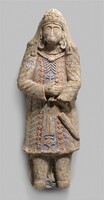Standing guards with ornamented headdresses
Type:
Sculptures
Date:
Twelfth or early thirteenth century
Location or Findspot (Modern-Day Country):
Iran
Medium:
Stucco
Dimensions:
143.5 × 51.5 × 25.4 cm (for the first figure) and 119.4 × 52.1 × 22.2 cm (for the second figure)
Description:
The richly ornamented vestments and headdresses of these large-scale sculptural figures, as well as their swords, suggest that they were personal royal guards or viziers/amirs, designed to stand in the reception hall of an unknown ruler's court (the Seljuq sultan or one of his local vassals). Tiraz bands on their sleeves have Arabic inscriptions in Kufic script that may quote from the Qur'an. They belong to a larger set of figures now in different museum collections. Some of the pigments are later restorations, and it is now unclear exactly how the modeled and carved gypsum plaster was originally polychromed or gilded. These figures show a revival of pre-Islamic, Sasanian motifs that were meant to tie the new dynasties of Iranian and Turkish origin to the royal traditions of the past.
Relevant Textbook Chapter(s):
7,
8
Repository and Online Resources:
• Read more about the standing figure with jeweled headdress on the website of the Metropolitan Museum of Art.
• Read more about the standing figure with feathered headdress on the website of the Metropolitan Museum of Art.


